INF30005: Business Process Management - Swinburne Logistics Group
VerifiedAdded on 2023/04/25
|16
|2543
|357
Report
AI Summary
This report provides an analysis of the current business processes within the Swinburne Logistics Group, highlighting inefficiencies and areas for improvement. The analysis reveals that the warehouse operations suffer from data flow and integrity issues due to reliance on manual, paper-based processes, which hinder management's control and negatively impact delivery scheduling, leading to customer dissatisfaction. The report outlines key assumptions made during the process model creation, details the issues with existing processes such as manual delivery time arrangement and paper-based information sharing, and presents BPMN diagrams illustrating processes like contract signing and delivery. Furthermore, the report discusses essential steps for process redesign, emphasizing the importance of recognizing requirements for change, assembling a skilled team, identifying inefficient processes, defining KPIs, and comparing the reengineered processes against these KPIs to ensure alignment with organizational objectives. Ultimately, the report suggests that implementing new technologies to automate back-office processes can address the gaps in the existing system and improve overall efficiency.
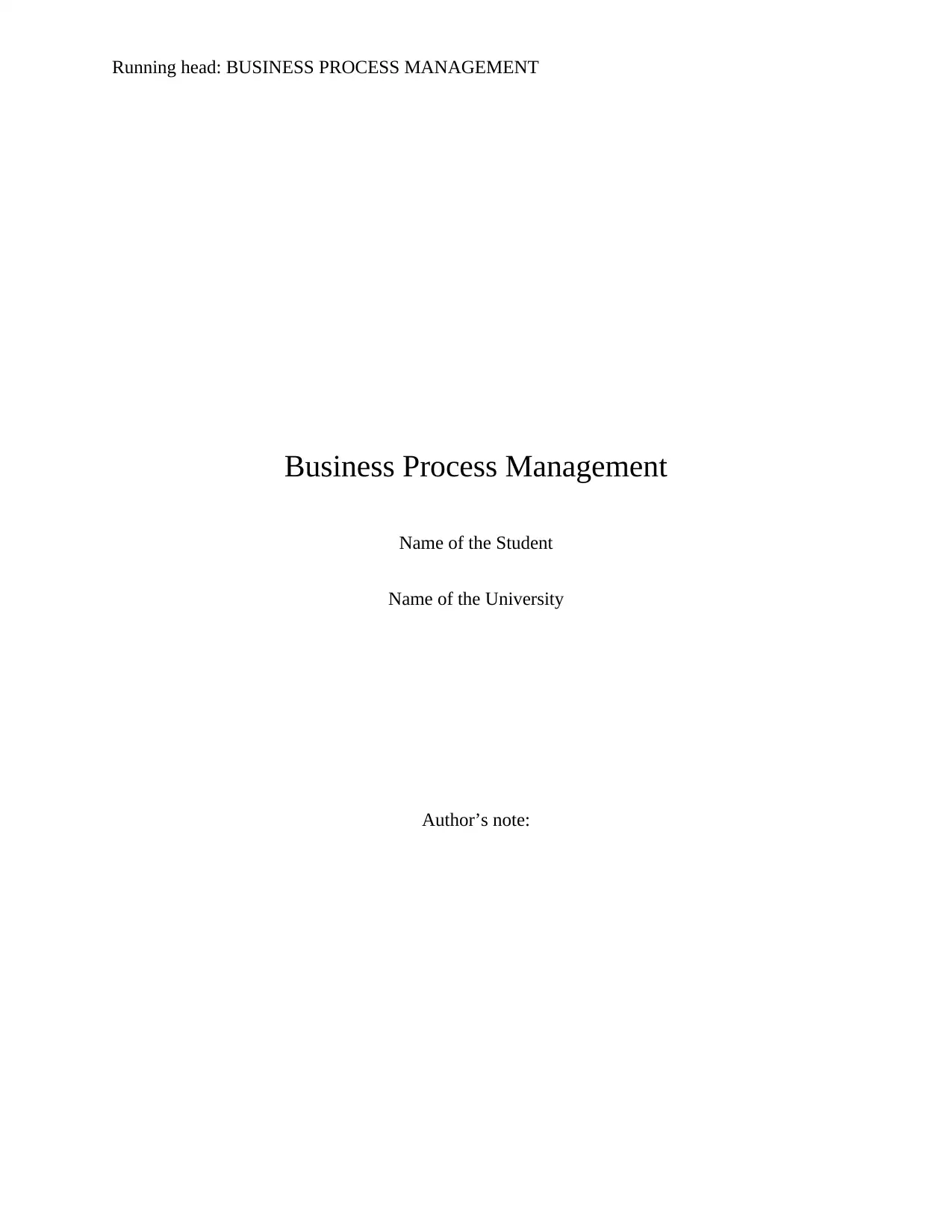
Running head: BUSINESS PROCESS MANAGEMENT
Business Process Management
Name of the Student
Name of the University
Author’s note:
Business Process Management
Name of the Student
Name of the University
Author’s note:
Paraphrase This Document
Need a fresh take? Get an instant paraphrase of this document with our AI Paraphraser
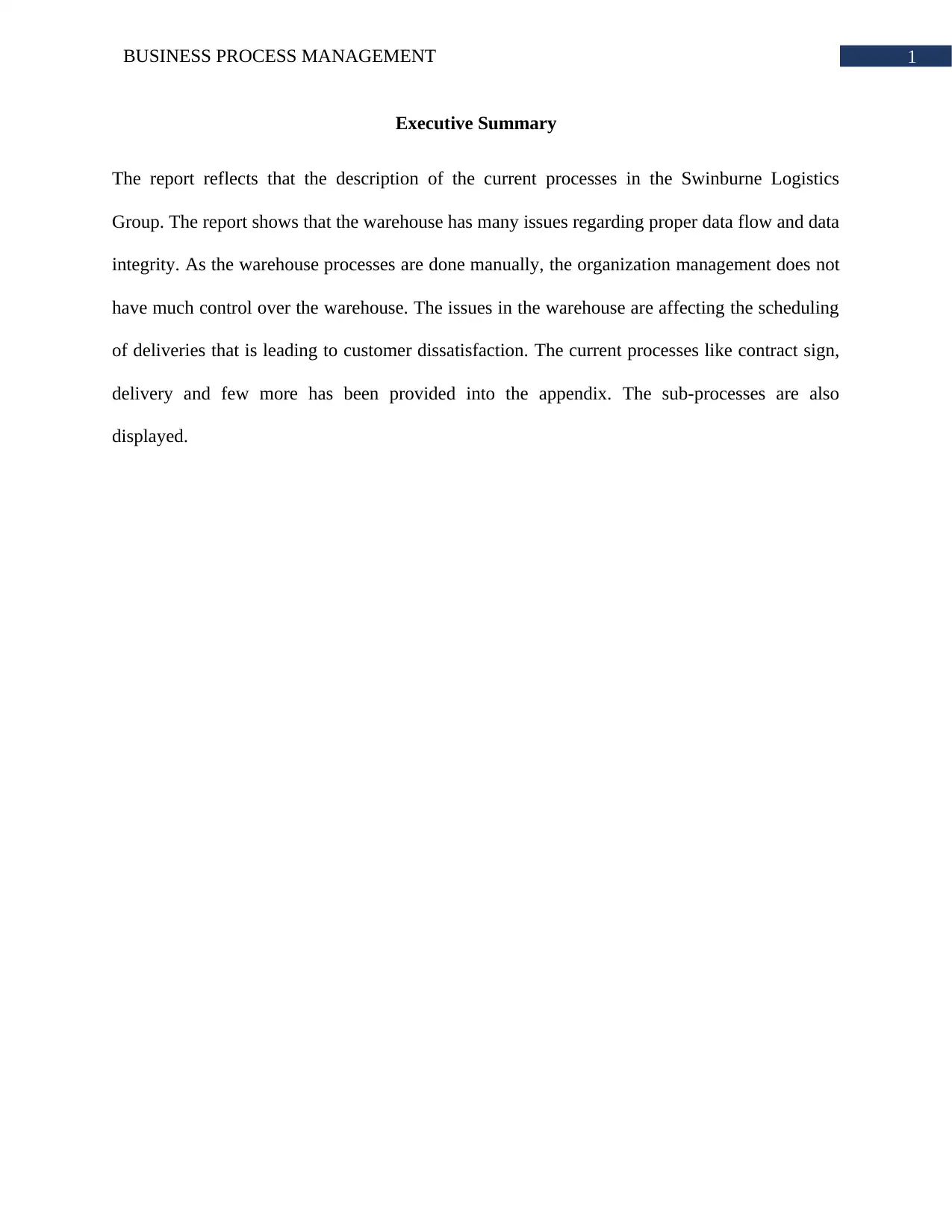
1BUSINESS PROCESS MANAGEMENT
Executive Summary
The report reflects that the description of the current processes in the Swinburne Logistics
Group. The report shows that the warehouse has many issues regarding proper data flow and data
integrity. As the warehouse processes are done manually, the organization management does not
have much control over the warehouse. The issues in the warehouse are affecting the scheduling
of deliveries that is leading to customer dissatisfaction. The current processes like contract sign,
delivery and few more has been provided into the appendix. The sub-processes are also
displayed.
Executive Summary
The report reflects that the description of the current processes in the Swinburne Logistics
Group. The report shows that the warehouse has many issues regarding proper data flow and data
integrity. As the warehouse processes are done manually, the organization management does not
have much control over the warehouse. The issues in the warehouse are affecting the scheduling
of deliveries that is leading to customer dissatisfaction. The current processes like contract sign,
delivery and few more has been provided into the appendix. The sub-processes are also
displayed.
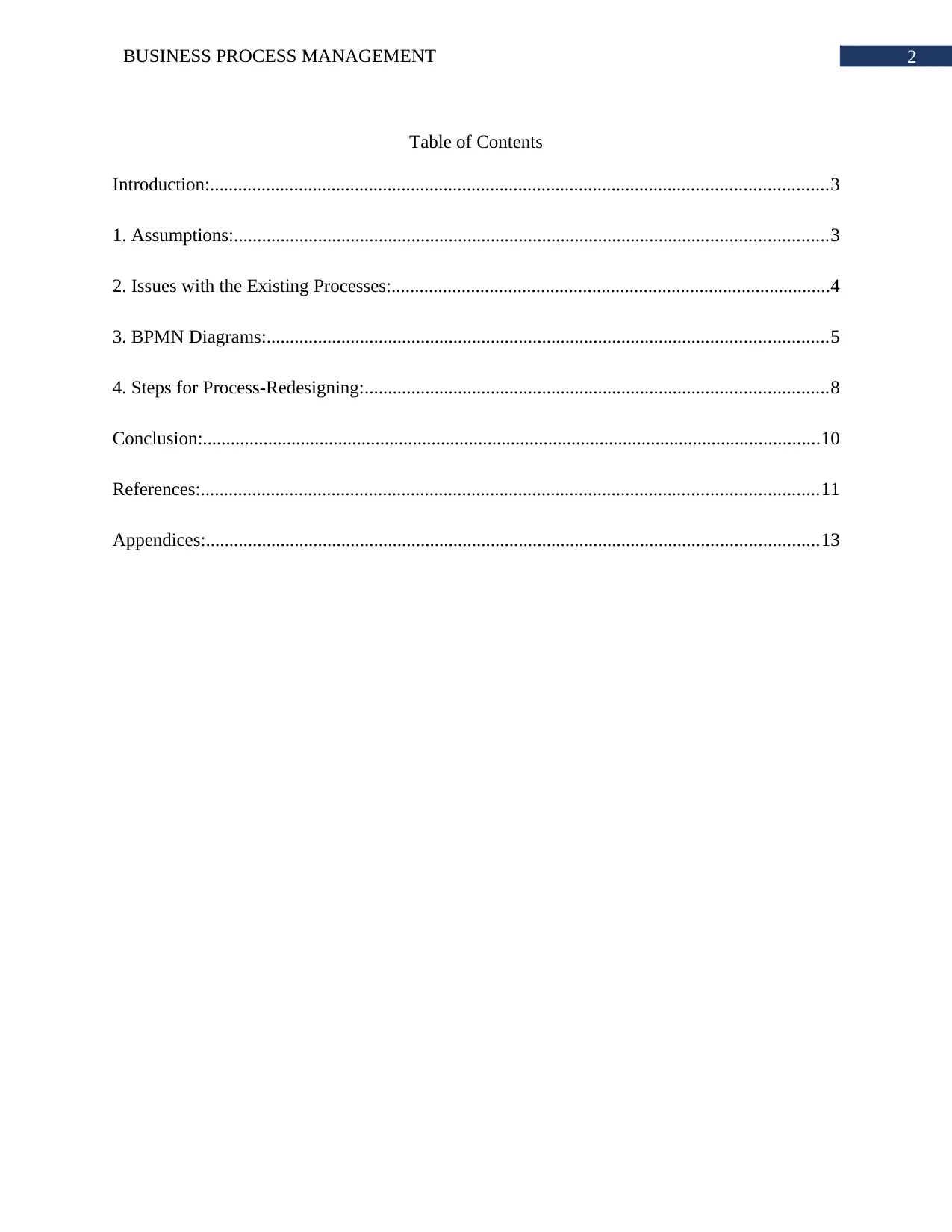
2BUSINESS PROCESS MANAGEMENT
Table of Contents
Introduction:....................................................................................................................................3
1. Assumptions:...............................................................................................................................3
2. Issues with the Existing Processes:..............................................................................................4
3. BPMN Diagrams:........................................................................................................................5
4. Steps for Process-Redesigning:...................................................................................................8
Conclusion:....................................................................................................................................10
References:....................................................................................................................................11
Appendices:...................................................................................................................................13
Table of Contents
Introduction:....................................................................................................................................3
1. Assumptions:...............................................................................................................................3
2. Issues with the Existing Processes:..............................................................................................4
3. BPMN Diagrams:........................................................................................................................5
4. Steps for Process-Redesigning:...................................................................................................8
Conclusion:....................................................................................................................................10
References:....................................................................................................................................11
Appendices:...................................................................................................................................13
⊘ This is a preview!⊘
Do you want full access?
Subscribe today to unlock all pages.

Trusted by 1+ million students worldwide

3BUSINESS PROCESS MANAGEMENT
Introduction:
The process modelling or business process modelling provides a graphical visualization
of business processes (Milani et al. 2016). The business processes are the internal or external
tasks of an organization that is either executed automatically or with the intervention of the
human. The process modelling allows the organizations to identify the gaps in the organizational
processes and provide an acute element for effective management of business processes. The
process models can be categorized into two parts called, as-is process and to-be process (Chang
2016). The business process re-engineering is the activity of regenerating core business
processes with the objective of increasing the quality of product, productivity and reducing the
cost of operations. The As-Is model is created to capture the current processes of an
organization.
The report is created based on the information of Swinburne Logistics Group. The
organization is one of the leading integrated logistic provider in the region of Asia Pacific. The
report has included the assumptions made during process model creation along with the issues in
the current process. The report also provide a detailed general description of business process
redesigning. The diagrams have been created based on the information provided and assumptions
made through experiences.
1. Assumptions:
The biggest assumption made during the business process reengineering is that the
warehouse department works through the paper based information. Each of the information
shared among the internal employees of the warehouse of Swinburne Logistics Group is done
manually. That is why the organization is facing problem with keeping the warehouse data
Introduction:
The process modelling or business process modelling provides a graphical visualization
of business processes (Milani et al. 2016). The business processes are the internal or external
tasks of an organization that is either executed automatically or with the intervention of the
human. The process modelling allows the organizations to identify the gaps in the organizational
processes and provide an acute element for effective management of business processes. The
process models can be categorized into two parts called, as-is process and to-be process (Chang
2016). The business process re-engineering is the activity of regenerating core business
processes with the objective of increasing the quality of product, productivity and reducing the
cost of operations. The As-Is model is created to capture the current processes of an
organization.
The report is created based on the information of Swinburne Logistics Group. The
organization is one of the leading integrated logistic provider in the region of Asia Pacific. The
report has included the assumptions made during process model creation along with the issues in
the current process. The report also provide a detailed general description of business process
redesigning. The diagrams have been created based on the information provided and assumptions
made through experiences.
1. Assumptions:
The biggest assumption made during the business process reengineering is that the
warehouse department works through the paper based information. Each of the information
shared among the internal employees of the warehouse of Swinburne Logistics Group is done
manually. That is why the organization is facing problem with keeping the warehouse data
Paraphrase This Document
Need a fresh take? Get an instant paraphrase of this document with our AI Paraphraser

4BUSINESS PROCESS MANAGEMENT
updated. Often the error data in the warehouse is creating issues in managing the delivery
schedule. Often the organization face issues with colliding delivery time and the whole process
gets disrupted. It has often happened that Swinburne Logistics is delivering a lot more frequently
in a day than usual. This leads to decrease in quality of service.
It is also assumed that the organization is willing to implement a new system that can
connect all the components. Each of the departments will be connected to the core of the system
and the system will have a database to store the data instead of paper.
2. Issues with the Existing Processes:
Arranging Delivery Time Manually: The Floor Supervisor of Swinburne Logistics is
responsible for managing the delivery time of the goods. The Swinburne Logistics has operation
managers who sign contracts with the clients. Contracts are signed, Swinburne Logistics collects
the information of the goods to be shipped and along with the destination information. As the
organization has a lot of clients and delivers too many goods to the destination, it is quite hectic
to check the stored delivery time and find a suitable one manually. Often the organization face
issues with colliding delivery time and the whole process gets disrupted. It has often happened
that Swinburne Logistics is delivering a lot more frequently in a day than usual. This leads to
decrease in quality of service. Often the organization has no driver to assign the service. Another
issue that happens in Swinburne Logistics is that there are often no slot left for delivering an
urgent service. The operators have to re-arrange the whole shipment schedule just to make sure
that everything is done properly.
The organization can implement a new and advanced scheduling process that will reduce
the error to approximately zero. There will be free slots for adding new emergency deliveries.
updated. Often the error data in the warehouse is creating issues in managing the delivery
schedule. Often the organization face issues with colliding delivery time and the whole process
gets disrupted. It has often happened that Swinburne Logistics is delivering a lot more frequently
in a day than usual. This leads to decrease in quality of service.
It is also assumed that the organization is willing to implement a new system that can
connect all the components. Each of the departments will be connected to the core of the system
and the system will have a database to store the data instead of paper.
2. Issues with the Existing Processes:
Arranging Delivery Time Manually: The Floor Supervisor of Swinburne Logistics is
responsible for managing the delivery time of the goods. The Swinburne Logistics has operation
managers who sign contracts with the clients. Contracts are signed, Swinburne Logistics collects
the information of the goods to be shipped and along with the destination information. As the
organization has a lot of clients and delivers too many goods to the destination, it is quite hectic
to check the stored delivery time and find a suitable one manually. Often the organization face
issues with colliding delivery time and the whole process gets disrupted. It has often happened
that Swinburne Logistics is delivering a lot more frequently in a day than usual. This leads to
decrease in quality of service. Often the organization has no driver to assign the service. Another
issue that happens in Swinburne Logistics is that there are often no slot left for delivering an
urgent service. The operators have to re-arrange the whole shipment schedule just to make sure
that everything is done properly.
The organization can implement a new and advanced scheduling process that will reduce
the error to approximately zero. There will be free slots for adding new emergency deliveries.
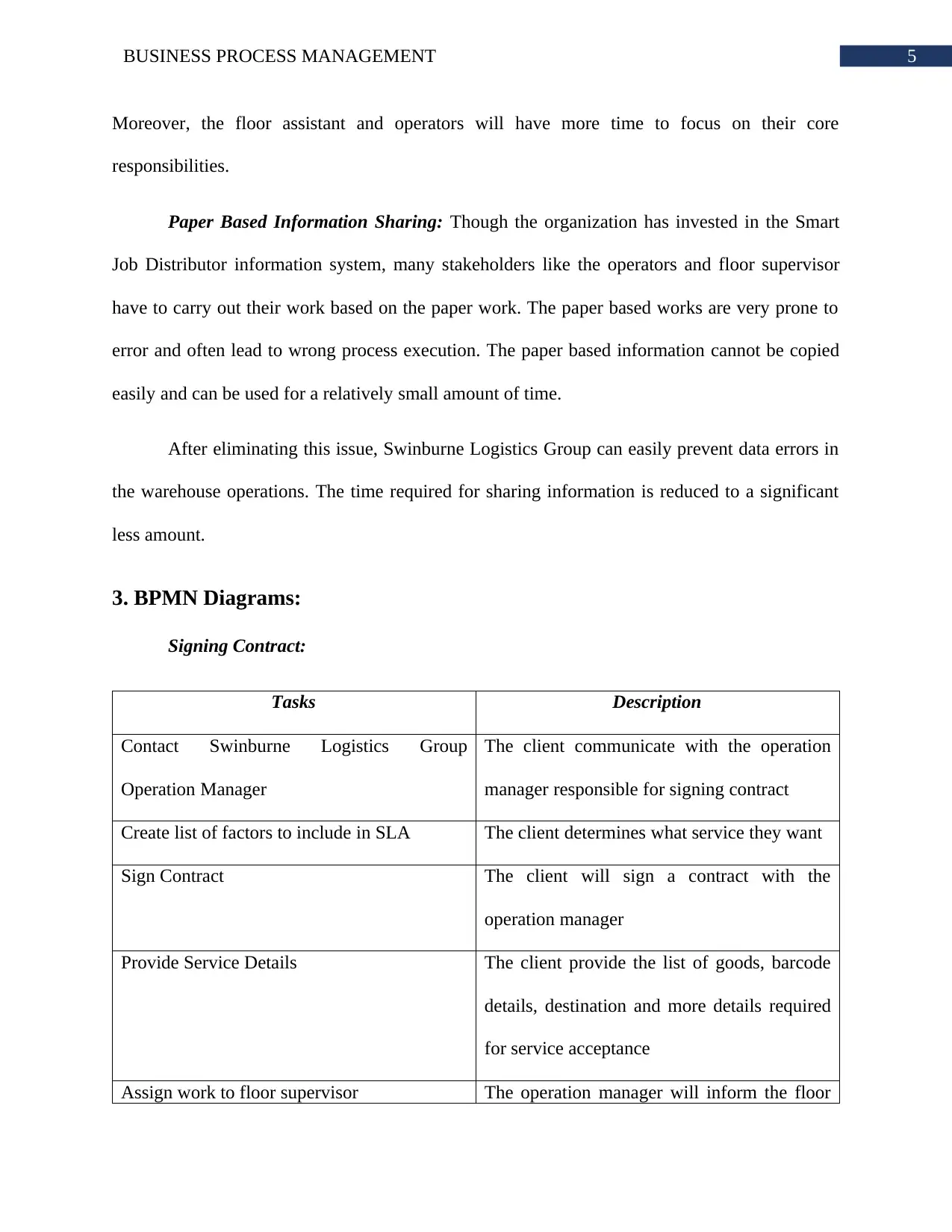
5BUSINESS PROCESS MANAGEMENT
Moreover, the floor assistant and operators will have more time to focus on their core
responsibilities.
Paper Based Information Sharing: Though the organization has invested in the Smart
Job Distributor information system, many stakeholders like the operators and floor supervisor
have to carry out their work based on the paper work. The paper based works are very prone to
error and often lead to wrong process execution. The paper based information cannot be copied
easily and can be used for a relatively small amount of time.
After eliminating this issue, Swinburne Logistics Group can easily prevent data errors in
the warehouse operations. The time required for sharing information is reduced to a significant
less amount.
3. BPMN Diagrams:
Signing Contract:
Tasks Description
Contact Swinburne Logistics Group
Operation Manager
The client communicate with the operation
manager responsible for signing contract
Create list of factors to include in SLA The client determines what service they want
Sign Contract The client will sign a contract with the
operation manager
Provide Service Details The client provide the list of goods, barcode
details, destination and more details required
for service acceptance
Assign work to floor supervisor The operation manager will inform the floor
Moreover, the floor assistant and operators will have more time to focus on their core
responsibilities.
Paper Based Information Sharing: Though the organization has invested in the Smart
Job Distributor information system, many stakeholders like the operators and floor supervisor
have to carry out their work based on the paper work. The paper based works are very prone to
error and often lead to wrong process execution. The paper based information cannot be copied
easily and can be used for a relatively small amount of time.
After eliminating this issue, Swinburne Logistics Group can easily prevent data errors in
the warehouse operations. The time required for sharing information is reduced to a significant
less amount.
3. BPMN Diagrams:
Signing Contract:
Tasks Description
Contact Swinburne Logistics Group
Operation Manager
The client communicate with the operation
manager responsible for signing contract
Create list of factors to include in SLA The client determines what service they want
Sign Contract The client will sign a contract with the
operation manager
Provide Service Details The client provide the list of goods, barcode
details, destination and more details required
for service acceptance
Assign work to floor supervisor The operation manager will inform the floor
⊘ This is a preview!⊘
Do you want full access?
Subscribe today to unlock all pages.

Trusted by 1+ million students worldwide
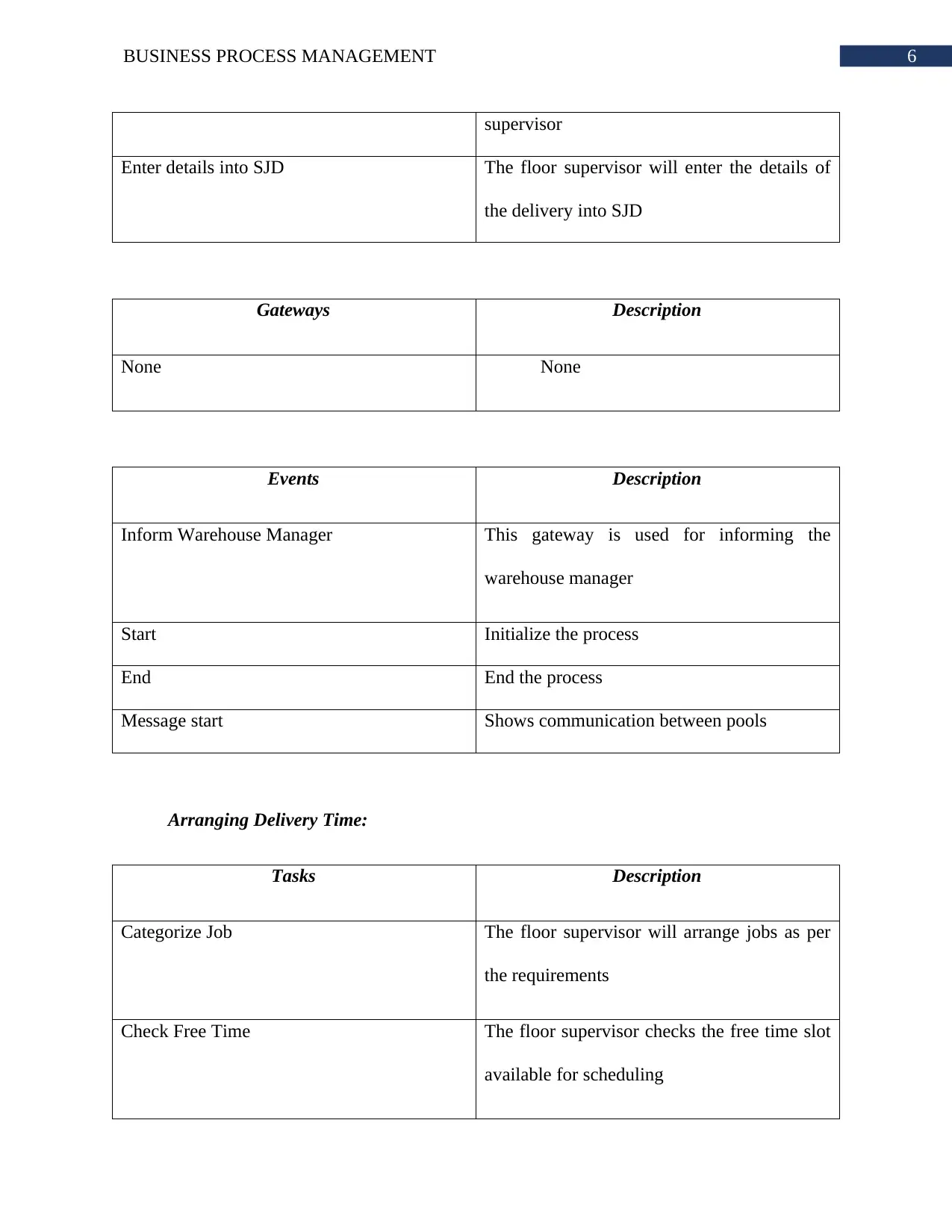
6BUSINESS PROCESS MANAGEMENT
supervisor
Enter details into SJD The floor supervisor will enter the details of
the delivery into SJD
Gateways Description
None None
Events Description
Inform Warehouse Manager This gateway is used for informing the
warehouse manager
Start Initialize the process
End End the process
Message start Shows communication between pools
Arranging Delivery Time:
Tasks Description
Categorize Job The floor supervisor will arrange jobs as per
the requirements
Check Free Time The floor supervisor checks the free time slot
available for scheduling
supervisor
Enter details into SJD The floor supervisor will enter the details of
the delivery into SJD
Gateways Description
None None
Events Description
Inform Warehouse Manager This gateway is used for informing the
warehouse manager
Start Initialize the process
End End the process
Message start Shows communication between pools
Arranging Delivery Time:
Tasks Description
Categorize Job The floor supervisor will arrange jobs as per
the requirements
Check Free Time The floor supervisor checks the free time slot
available for scheduling
Paraphrase This Document
Need a fresh take? Get an instant paraphrase of this document with our AI Paraphraser

7BUSINESS PROCESS MANAGEMENT
Schedule Delivery Time The floor supervisor will schedule the
delivery
Provide Service Details The client provide the list of goods, barcode
details, destination and more details required
for service acceptance
Assign work to floor supervisor The operation manager will inform the floor
supervisor
Enter details into SJD The floor supervisor will enter the details of
the delivery into SJD
Save Job In case the potential job quantity is low then
floor supervisor saves the jobs
Inform Operator Otherwise the floor supervisor informs the
operator
Check Delivery Jobs The floor supervisor after receiving the
information check available delivery jobs
Re-arrange the ground spaces for the new
delivery jobs
The operator then re-arrange the jobs to
resolve the issue
Gateways Description
Have many potential jobs? The floor supervisor checks if the shipment
includes many potential jobs
Schedule Delivery Time The floor supervisor will schedule the
delivery
Provide Service Details The client provide the list of goods, barcode
details, destination and more details required
for service acceptance
Assign work to floor supervisor The operation manager will inform the floor
supervisor
Enter details into SJD The floor supervisor will enter the details of
the delivery into SJD
Save Job In case the potential job quantity is low then
floor supervisor saves the jobs
Inform Operator Otherwise the floor supervisor informs the
operator
Check Delivery Jobs The floor supervisor after receiving the
information check available delivery jobs
Re-arrange the ground spaces for the new
delivery jobs
The operator then re-arrange the jobs to
resolve the issue
Gateways Description
Have many potential jobs? The floor supervisor checks if the shipment
includes many potential jobs

8BUSINESS PROCESS MANAGEMENT
Events Description
Start Initialize the process
End End the process
Message start Shows communication between pools
4. Steps for Process-Redesigning:
Recognition and Communication of Requirement for Change: For small organizations,
identifying the process requirements is a very easy task. However, for big organizations that has
complex processes, the requirement gathering is the most critical and vital task. The process has
always two sides, one is employees and the other is management (Chang 2016). Therefore, the
identified requirements should be able to satisfy both the management and employees. This way
management will think that their investment will not be wasted. In addition to that the employees
will not be afraid of their job security. The analyst who collects the requirement must prepare a
convincing document to the organizational stakeholders so that proposed process reengineering
is accepted. The planning for process reengineering should involve different department leaders
and the created plan must be very comprehensive (Esbenshade, Vidal, Fascilla and Ono 2016).
The management will act the middle man between the team and employees. They will convey
the benefits of the proposed changes in the process to the employees and other key stakeholders.
Risk of failure is very high in process reengineering and if the management is not cooperative
with the team then projects actually becomes a failure. Some people may experience negative
Events Description
Start Initialize the process
End End the process
Message start Shows communication between pools
4. Steps for Process-Redesigning:
Recognition and Communication of Requirement for Change: For small organizations,
identifying the process requirements is a very easy task. However, for big organizations that has
complex processes, the requirement gathering is the most critical and vital task. The process has
always two sides, one is employees and the other is management (Chang 2016). Therefore, the
identified requirements should be able to satisfy both the management and employees. This way
management will think that their investment will not be wasted. In addition to that the employees
will not be afraid of their job security. The analyst who collects the requirement must prepare a
convincing document to the organizational stakeholders so that proposed process reengineering
is accepted. The planning for process reengineering should involve different department leaders
and the created plan must be very comprehensive (Esbenshade, Vidal, Fascilla and Ono 2016).
The management will act the middle man between the team and employees. They will convey
the benefits of the proposed changes in the process to the employees and other key stakeholders.
Risk of failure is very high in process reengineering and if the management is not cooperative
with the team then projects actually becomes a failure. Some people may experience negative
⊘ This is a preview!⊘
Do you want full access?
Subscribe today to unlock all pages.

Trusted by 1+ million students worldwide

9BUSINESS PROCESS MANAGEMENT
impact from the process reengineering. The management must find new ways to make change
work for those people too.
Put Together a Team of Skilled Personnel: Like any other project, the process
reengineering must be completed by experienced and skilled team. Each of the member of the
team will be responsible for carrying out different responsibilities. Each of them must be able to
handle the tasks assigned to them skillfully. The teams are generally consisting of senior
manager, operation manager, reengineering exert. In order to taken the most vital decisions, a
higher management executive of the organization must only be allowed to take decisions (Huang
et al. 2015). The senior manager is responsible for supervising the whole process reengineering
activity. Sometimes, the business process reengineering team may not have a senior manager
included within it. In such cases, the team will communicate with the organization management
to make every simple changes. The team will have a person who knows the existing processes
very well. The operation manager is included into the team because he/she can identify whether
the new processes is able to implement the input/output of the process. If the operation manager
guide the process reengineering task then they can contribute to make the new process follow the
objective of the organization (Bertolini et al. 2015). This is extremely vital because it will ensure
that new process can contribute to growth and profit of the business while maintaining
organization policy. Interference of operation manager reduces the possibility of process
reengineering failure.
Identifying the Inefficient Processes and Defining the KPI: If the team is ready to start
working on the project, the project manager will create a list of key performance indicators or
KPI. It is essential to create the key performance indicators before the team completes
reengineering the processes. If the KPIs are not defined then team may find that created new
impact from the process reengineering. The management must find new ways to make change
work for those people too.
Put Together a Team of Skilled Personnel: Like any other project, the process
reengineering must be completed by experienced and skilled team. Each of the member of the
team will be responsible for carrying out different responsibilities. Each of them must be able to
handle the tasks assigned to them skillfully. The teams are generally consisting of senior
manager, operation manager, reengineering exert. In order to taken the most vital decisions, a
higher management executive of the organization must only be allowed to take decisions (Huang
et al. 2015). The senior manager is responsible for supervising the whole process reengineering
activity. Sometimes, the business process reengineering team may not have a senior manager
included within it. In such cases, the team will communicate with the organization management
to make every simple changes. The team will have a person who knows the existing processes
very well. The operation manager is included into the team because he/she can identify whether
the new processes is able to implement the input/output of the process. If the operation manager
guide the process reengineering task then they can contribute to make the new process follow the
objective of the organization (Bertolini et al. 2015). This is extremely vital because it will ensure
that new process can contribute to growth and profit of the business while maintaining
organization policy. Interference of operation manager reduces the possibility of process
reengineering failure.
Identifying the Inefficient Processes and Defining the KPI: If the team is ready to start
working on the project, the project manager will create a list of key performance indicators or
KPI. It is essential to create the key performance indicators before the team completes
reengineering the processes. If the KPIs are not defined then team may find that created new
Paraphrase This Document
Need a fresh take? Get an instant paraphrase of this document with our AI Paraphraser
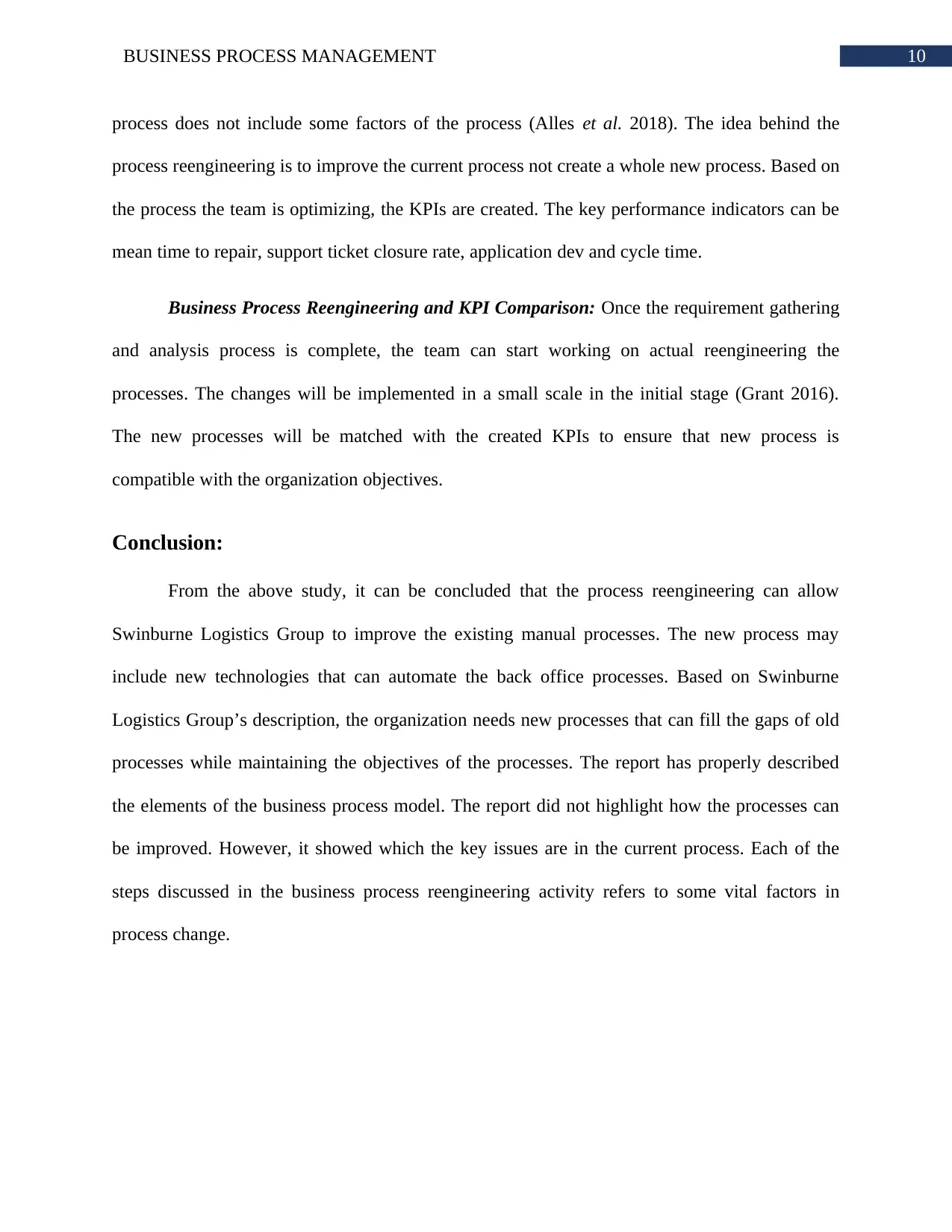
10BUSINESS PROCESS MANAGEMENT
process does not include some factors of the process (Alles et al. 2018). The idea behind the
process reengineering is to improve the current process not create a whole new process. Based on
the process the team is optimizing, the KPIs are created. The key performance indicators can be
mean time to repair, support ticket closure rate, application dev and cycle time.
Business Process Reengineering and KPI Comparison: Once the requirement gathering
and analysis process is complete, the team can start working on actual reengineering the
processes. The changes will be implemented in a small scale in the initial stage (Grant 2016).
The new processes will be matched with the created KPIs to ensure that new process is
compatible with the organization objectives.
Conclusion:
From the above study, it can be concluded that the process reengineering can allow
Swinburne Logistics Group to improve the existing manual processes. The new process may
include new technologies that can automate the back office processes. Based on Swinburne
Logistics Group’s description, the organization needs new processes that can fill the gaps of old
processes while maintaining the objectives of the processes. The report has properly described
the elements of the business process model. The report did not highlight how the processes can
be improved. However, it showed which the key issues are in the current process. Each of the
steps discussed in the business process reengineering activity refers to some vital factors in
process change.
process does not include some factors of the process (Alles et al. 2018). The idea behind the
process reengineering is to improve the current process not create a whole new process. Based on
the process the team is optimizing, the KPIs are created. The key performance indicators can be
mean time to repair, support ticket closure rate, application dev and cycle time.
Business Process Reengineering and KPI Comparison: Once the requirement gathering
and analysis process is complete, the team can start working on actual reengineering the
processes. The changes will be implemented in a small scale in the initial stage (Grant 2016).
The new processes will be matched with the created KPIs to ensure that new process is
compatible with the organization objectives.
Conclusion:
From the above study, it can be concluded that the process reengineering can allow
Swinburne Logistics Group to improve the existing manual processes. The new process may
include new technologies that can automate the back office processes. Based on Swinburne
Logistics Group’s description, the organization needs new processes that can fill the gaps of old
processes while maintaining the objectives of the processes. The report has properly described
the elements of the business process model. The report did not highlight how the processes can
be improved. However, it showed which the key issues are in the current process. Each of the
steps discussed in the business process reengineering activity refers to some vital factors in
process change.
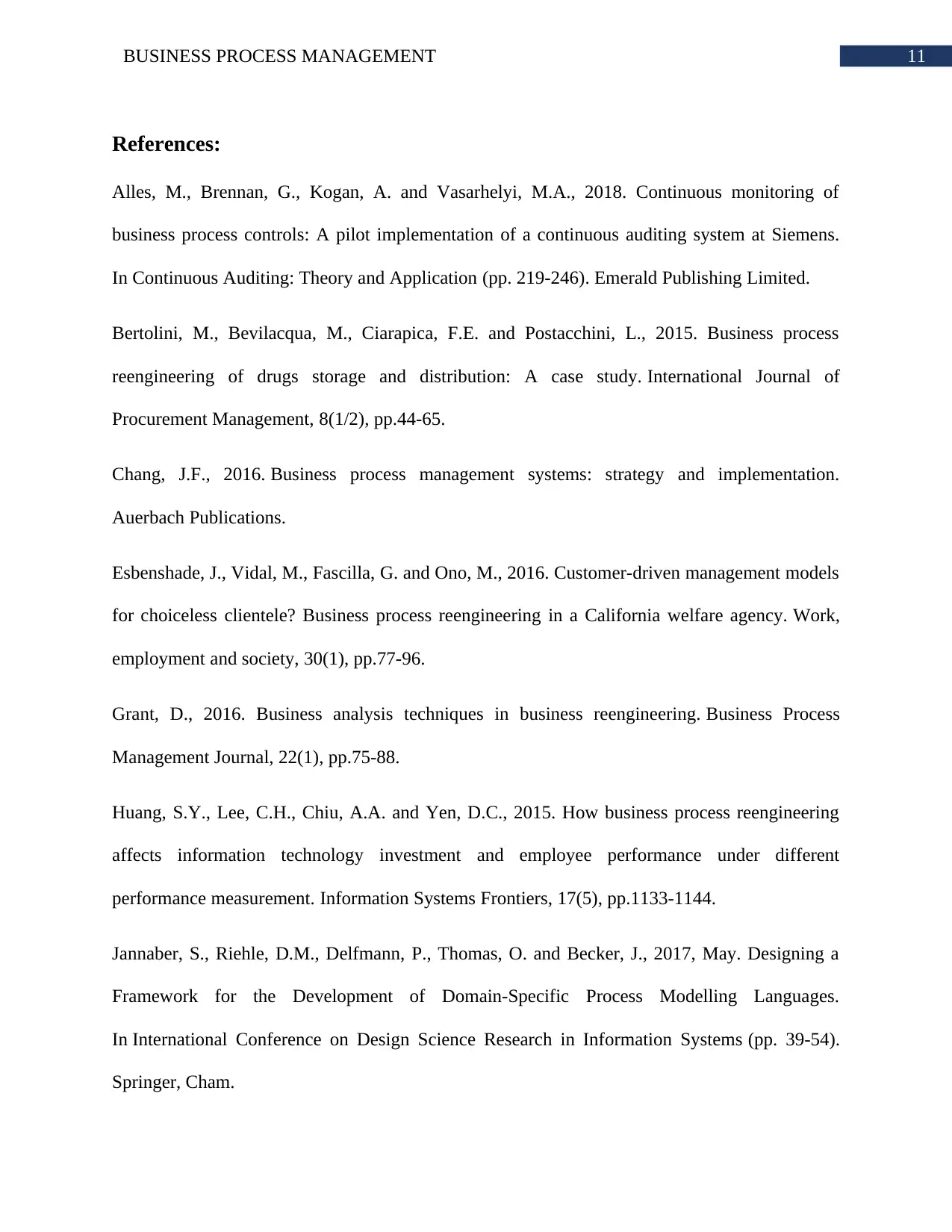
11BUSINESS PROCESS MANAGEMENT
References:
Alles, M., Brennan, G., Kogan, A. and Vasarhelyi, M.A., 2018. Continuous monitoring of
business process controls: A pilot implementation of a continuous auditing system at Siemens.
In Continuous Auditing: Theory and Application (pp. 219-246). Emerald Publishing Limited.
Bertolini, M., Bevilacqua, M., Ciarapica, F.E. and Postacchini, L., 2015. Business process
reengineering of drugs storage and distribution: A case study. International Journal of
Procurement Management, 8(1/2), pp.44-65.
Chang, J.F., 2016. Business process management systems: strategy and implementation.
Auerbach Publications.
Esbenshade, J., Vidal, M., Fascilla, G. and Ono, M., 2016. Customer-driven management models
for choiceless clientele? Business process reengineering in a California welfare agency. Work,
employment and society, 30(1), pp.77-96.
Grant, D., 2016. Business analysis techniques in business reengineering. Business Process
Management Journal, 22(1), pp.75-88.
Huang, S.Y., Lee, C.H., Chiu, A.A. and Yen, D.C., 2015. How business process reengineering
affects information technology investment and employee performance under different
performance measurement. Information Systems Frontiers, 17(5), pp.1133-1144.
Jannaber, S., Riehle, D.M., Delfmann, P., Thomas, O. and Becker, J., 2017, May. Designing a
Framework for the Development of Domain-Specific Process Modelling Languages.
In International Conference on Design Science Research in Information Systems (pp. 39-54).
Springer, Cham.
References:
Alles, M., Brennan, G., Kogan, A. and Vasarhelyi, M.A., 2018. Continuous monitoring of
business process controls: A pilot implementation of a continuous auditing system at Siemens.
In Continuous Auditing: Theory and Application (pp. 219-246). Emerald Publishing Limited.
Bertolini, M., Bevilacqua, M., Ciarapica, F.E. and Postacchini, L., 2015. Business process
reengineering of drugs storage and distribution: A case study. International Journal of
Procurement Management, 8(1/2), pp.44-65.
Chang, J.F., 2016. Business process management systems: strategy and implementation.
Auerbach Publications.
Esbenshade, J., Vidal, M., Fascilla, G. and Ono, M., 2016. Customer-driven management models
for choiceless clientele? Business process reengineering in a California welfare agency. Work,
employment and society, 30(1), pp.77-96.
Grant, D., 2016. Business analysis techniques in business reengineering. Business Process
Management Journal, 22(1), pp.75-88.
Huang, S.Y., Lee, C.H., Chiu, A.A. and Yen, D.C., 2015. How business process reengineering
affects information technology investment and employee performance under different
performance measurement. Information Systems Frontiers, 17(5), pp.1133-1144.
Jannaber, S., Riehle, D.M., Delfmann, P., Thomas, O. and Becker, J., 2017, May. Designing a
Framework for the Development of Domain-Specific Process Modelling Languages.
In International Conference on Design Science Research in Information Systems (pp. 39-54).
Springer, Cham.
⊘ This is a preview!⊘
Do you want full access?
Subscribe today to unlock all pages.

Trusted by 1+ million students worldwide
1 out of 16
Related Documents
Your All-in-One AI-Powered Toolkit for Academic Success.
+13062052269
info@desklib.com
Available 24*7 on WhatsApp / Email
![[object Object]](/_next/static/media/star-bottom.7253800d.svg)
Unlock your academic potential
Copyright © 2020–2025 A2Z Services. All Rights Reserved. Developed and managed by ZUCOL.




